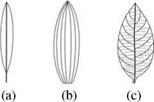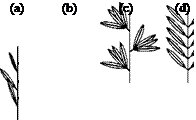No matter how leaves evolved, it may be through evolution, as suggested by the telome theory, through planation, and/or deformation, or through other mechanisms, a leaf consists of four main parts, the leaf blade, the expanded portion of the leaf, the petiole (leaf base), the rhachis (leaf stalk), connecting the blade to the stem, and the lamina (stem clasping). There is an infinite variety of shapes, which can roughly be categorized into pinnate compound leaves, palmate compound leaves, lance-like leaves with parallel venation, and leaves with net veins or reticulate venation patterns (see Fig. 2.6).
![]()
 Figure 2.6
Figure 2.6
Different types of leaf shapes:
(a) single-veined pinnate; (b) lance-like with parallel veins; (c) differentiated leaves with net veins
The last-mentioned shape, which is characteristic for most deciduous trees, anchors the leaf base to the shoot axis (petiole). Leaves in which the blade attaches directly to the stem or surrounds the stem are termed sessile leaves. An extreme form is the lamina with a fused basal rim evoking the impression of a leaf that the shoot grows through. The base of the stalk may even grow down on the shoot a little bit further. The leaf stem is structured similar to an axis. The so-called sheath-forming petiole surrounds the shoot for stability. Some types of leaves are equipped with a petiole joint, which allows for movement. Leaf anatomy distinguishes between various kinds of leaf types: while bifacial leaves clearly show a differentiation between the tissue of the upper and lower side, equifacial leaves have assimilation tissue on both sides. Unifacial leaves, such as lance-like leaves with parallel venation, also show the assimilation tissue on both sides under the epidermis.
Since computer graphics is more interested in the actual appearance rather than in the function of leaves, it is not necessary to further pursue the subject. Nevertheless, in Chap. 9 we present a light simulation in combination with a detailed leaf model containing several layers. The simulation is able to represent various reflection properties of leaves.

![]()
 |
We turn briefly to leaf development, i. e., the changes in leaf shapes during the life and yearly cycle of a plant. During the life cycle and within each growth period, a plant produces various types of leaves. First juvenile (shoot) leaves are formed, in order to store the first nutrients for the shoot or to produce nutrients with the help of photosynthesis. A multiplicity of secondary leaves later takes over the nutrient supply. Then the petals (cup and crown leaves) follow, which together with the stamens and carpels (pistils) form the blossom.
Depending upon their development, the secondary leaves continue to mature differently in the nodes. With water plants usually triple nodes with a rootlike leaf and two swimming leaves develop. Also along the branch axis such changes can occur, for example if the newly formed areas of the plant serve a new purpose such as reproduction.
The above-mentioned leaf models with parallel and netvenation, are further categorized according to their shapes (Fig. 2.7). Netveined leaves are divided into palmately lobed leaves with pronounced margins, into pinnately lobed or netted or arched leaves. Other shapes are possible, depending on the type of the leaf margins, the development of the leaf margin, the presence of a stem, as well as the leaf base.
 |
||
 |
||
Leaves of deciduous trees are further divided into simple and compound leaves. Compound leaves with three leaflets, such as clover, are said to be ternate. Figure 2.8 illustrates the most important shapes; more details may be found in [110].
The structure of the conifer leaf deviates very much from that of the deciduous tree leaf. Most needle leafs are perennial and have triangular or square cross
sections with bifacial structures. At the branches, the leaves are arranged spirallike, opposite, whorled or cluster-scaled.
![]() The modern ginkgo has a special leaf shape: though it is a tree with a coniferlike architecture, the fan-shaped leaves are flat and irregularly notched. These uniquely pronounced characteristics are due to its ancestry. The ginkgophytes are an ancient group that attained maximum diversity in the Jurassic Period. They are also typified as living fossils, since their structure has changed very little since then.
The modern ginkgo has a special leaf shape: though it is a tree with a coniferlike architecture, the fan-shaped leaves are flat and irregularly notched. These uniquely pronounced characteristics are due to its ancestry. The ginkgophytes are an ancient group that attained maximum diversity in the Jurassic Period. They are also typified as living fossils, since their structure has changed very little since then.



